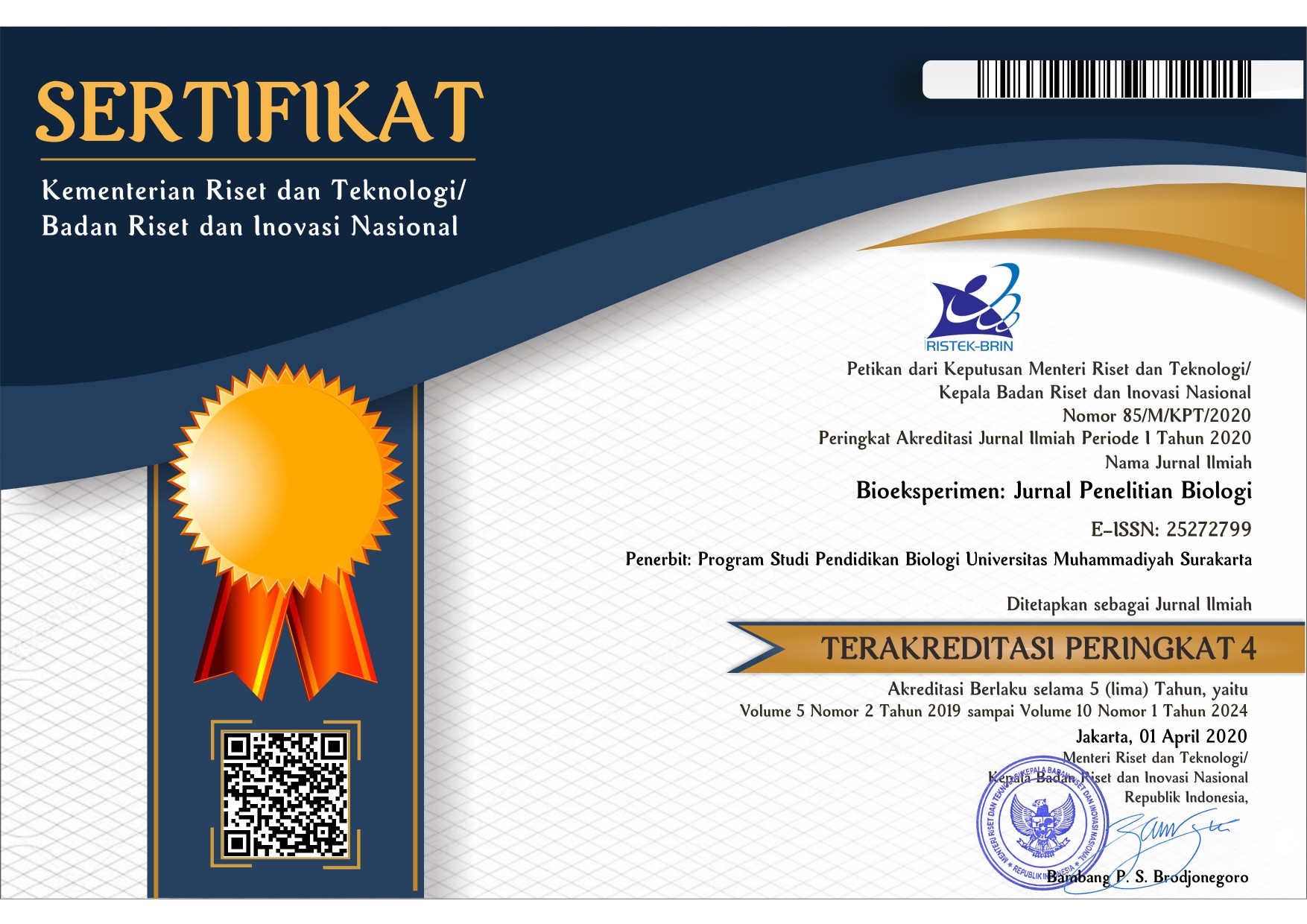Variasi Pertumbuhan dan Pembuahan Klon Jati (Tectona grandis L.f.) Umur 11 Tahun
Liliana Baskorowati(1*), Hamdan Adma Adinugraha(2), Mashudi Mashudi(3)(1)
(2) Balai Besar Penelitian dan Pengembangan Bioteknologi dan Pemuliaan Tanaman Hutan
(3) Balai Besar Penelitian dan Pengembangan Bioteknologi dan Pemuliaan Tanaman Hutan
(*) Corresponding Author
Abstract
Keywords
Full Text:
PDF (Bahasa Indonesia)References
Adinugraha, H. A., & Mahfudz. (2016). Estimati parameter genetik uji klon jati umur 5 tahun di Wonogiri, Jawa Tengah. WASIAN, 3(1), 17–23.
Baskorowati, L., & Fauzi, M. A. (2013). Biologi Jati. In Benih Unggul untuk Pengembangan Hutan Jati Rakyat. (pp. 05–11). FORDA PRESS bekerjasama dengan Balai Besar Penelitian Bioteknologi dan Pemuliaan Tanaman Hutan.
Bila, A. D., Lindgren, D., & Mullin, T. J. (1999). Fertility variation and its effect on diversity over generations in a teak plantation (Tectona grandis L.f. L.f.). Silvae Genetica, 48(3–4), 109–114.
D. K. S. Goh, Japarudin, Y., Alwi, A., Lapammu, M., Floris, A., & Monteuuis, O. (2013). Growth differences and genetic parameter estimates of 15 teak (Tectona grandis L.f. L.f.) genotypes of various ages clonally propagated by microcuttings and planted under humid tropical conditions. Silvae Genetica, 62(4–5), 196–206.
Fitriani, A. (2012). Evaluasi Pertumbuhan Tanaman Jati Pada Areal Gerakan Rehabilitasi Hutan dan Lahan. Jurnal Hutan Tropis, 13(1), 55–66.
Gunaga, R.P. and Vasudeva, R. (2005). Causes for low fruit production in clonal seed orchards of teak (Tectona grandis L.f. Linn): A special references to India. In J. K. Bhat, K.M., Nair, K.K.N. Bhat, K.V., Muralidharan, E.M. and Sharma (Ed.), Quality Timber Products of Teak from Sustainable Forest Management (pp. 352–358). Published by KFRI, Peechi.
Gunaga, R. P., Kanfade, A. H., & Vasudeva, R. (2011). Soil fertility status of 20 seed production areas of Tectona grandis L.f. Linn. f. in Karnataka, India. Journal of Forest Science, 57(11), 483–490.
Harbagung, I., & Imanuddin, R. (2009). Penentuan Ukuran Optimal Petak Ukur Permanen Untuk Hutan Tanaman Jati. Jurnal Penelitian Hutan Dan Konservasi Alam, 6(1), 57–68.
Indira, E. P. (2005). Why teak seed orchards are low productive. In Quality Timber Products of Teak from Sustainable Forest Management (Eds.) Bhat, K.M., Nair, KKN, Bhat, K.V., Muralidharan, E.M. and Sharma, J.K., (pp. 347–351).
Jackson, D. I., & Sweet, G. . (1972). Flower initiation in temperate woody plants. Horticultural Abstracts, 42, 9–24.
K. Palanisamy, Maheshwar, H., & Yi, J.-S. (2009). Teak (Tectona grandis L.f. Linn. f.): A Renowned CommercialTimber Species. Journal of Forest Science, 25(1), 1–24.
Kaosa-ard, A. (1981). Teak its natural distribution and related factors. Nat. His. Bull. Siam. Soc, 29, 55–74.
Kramer, P. J., & Kozlowski, T. . (1960). Physiology of trees. Mc Grow Hill Book Company, New York.
Matthews, J. D. (1951). Forest genetics. Nature, 167(4254), 764. https://doi.org/10.1038/167764a0
Palupi, E. R., & Owens, J. N. (2002). Reproductive Phenology and Reproductive Success of Teak (Tectona grandis L.f. L. F.). International Journal of Plant Sciences. https://doi.org/10.1086/297604
Ramesh, V., & Gunaga, R. (2012). Flowering Phenology in Teak Seed Orchards–Genetic Variation, Measurement and Implications to Seed Orchard Fertility. Phenology and Climate Change, 320. Retrieved from http://cdn.intechopen.com/pdfs/32929/InTech-Flowering_phenology_in_teak_seed_orchards_genetic_variation_measurement_and_implications_to_seed_orchard_fertility.pdf
Sett, R., Mishra, J. P., & Rana, P. K. (2016). Seed production of teak in different orchards of central India: the present scenario. International Journal of Science, Environment and Technology, 5(3), 969–990.
Soerianegara, I., & Lemmens, R. H. M. . (1993). Plant resources of South-East Asia 5(1): Timber trees: major commercial timbers. Belanda, Wageningen: Pudoc Scientific Publishers.
Zobel, B., & Talbert, J. T. (1984). Applied Forest Tree Improvement. John Willey and Sons. New York: John Willey and Sons.
Article Metrics
Abstract view(s): 1361 time(s)PDF (Bahasa Indonesia): 1630 time(s)
Refbacks
- There are currently no refbacks.








